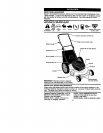
TO START ENGINE
NOTE: Due to protective coatingson the
engine, a small amount of smoke may be
present during the initialuse of the
product and should be considered
normal.
1. To start a cold engine, push primer
three (3) times before tryingto start.
Use a firm push. This step isnot
usually necessary when starting an
engine which has already run for a
few minutes.
2. Hold operator presence control bar
down to the handle and pull starter
handle quickly.Do not allow starter
rope to snap back.
TO STOP ENGINE
• To stop engine, release operator
presence control bar.
NOTE: ta cooler weather itmay be
necessary to repeat priming steps. In
warmer weather over pdming may cause
flooding and engine will not start. If you
do flood engine, wait a few minutes
before attempting to start and do not
repeat priming steps.
MOWINGTIPS
• Under certain conditions,such as very
tall grass, it may be necessary to raise
the height of cut to mduca pushing
effort and to keep from overloading the
engine and leaving clumps of grass
clippings. It may also be necessary to
reduce ground speed and/or run the
lawn mower over the area a second
time.
• For extremely heavy cutting, reduce the
width of cut by overlapping previously
cut path and mow slowly.
• For better grass bagging and most
cutting conditions, the engine speed
should be set in the fast position.
• Pores in cloth grass catchers can
become filled with dirt and dust with
use and catchers willcollect less grass.
To prevent this, regularly hose catcher
off withwater and let dry before using.
• Keep top of engine around starter clear
and clean of grass clippings and chaff.
This will help engine air flow and
extend engine life.
MULCHING MOWINGTIPS
IMPORTANT: For best performance,
keep mower housing free of built-up
grass and trash, See "CLEANING" inthe
Maintenance section of this manual.
• The special mulching blade will recur
the grass clippingsmany times and
reduce them in size sothat as they fall
onto the lawn they will disperse intothe
grass and not be noticed. Also, the
mulched grass will biodegrade quickly
to provide nutrientsfor the lawn.
Always mulch with your highest engine
(blade) speed as this will provide the
best recuttingaction of the blades.
• Avoid cutting your lawn when it is wet.
Wet grass tends to form clumps and
interferes with the mulchingaction, The
best time to mow your lawn is the eady
afternoon. At this time the grass has
dded and the newly cut area will not be
exposed to the direct sun.
• For best results, adjust the lawn mower
cutting height so that the lawn mower
cuts off only the top one-third of the
grass blades. If the lawn isovergrown it
will be necessary to raise the height of
cut to reduce pushing effort and to keep
from overloading the engine and
leaving dumps of mulched grass. For
extremely heavy mulching, reduce your
width of cut by overlapping previously
cut path and mow slowly.
• Certain types of grass and grass
conditions may require that an area be
mulched a second time to completely
hide the clippings,When doing a
second cut, mow across or perpendicu-
larto the firstcut path.
• Change your cutting pattern from week
to week. Mow north to south one week
then change to east towest the next
week. This will help prevent matting
and graining of the lawn,


















